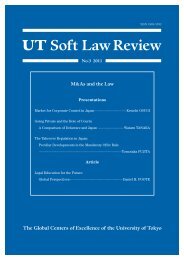<strong>UT</strong> <strong>Soft</strong> <strong>Law</strong> <strong>Review</strong> No.2 2010hostile takeovers in Japan has greatly changed.First, early in the 1990s, there were not many cases of corporate acquisitions includingfriendly takeovers, there were not many people who were capable of conducting corporateacquisitions, and the understanding about corporate acquisitions was not sufficient. TheJapanese TOB regulation was significantly amended in 1990 to create the framework of thecurrent structure. Prior to this amendment, there were only three TOB cases and even afterthe amendment the TOB was not used for four to five years. After that, the number of TOBcases started increasing dramatically. Also, during the bubble economy in the 1980’s, the term“acquisition” sometimes conveyed a negative impression, such as greenmailers, or “takeovers”by stock speculators; therefore, many business managers hesitated to use it, and society itselfhad some hesitation to accept it as well. Moreover, prior to the collapse of Japan’s bubbleeconomy in early 1990, cross-shareholdings were significantly more common than now, whichmade hostile takeovers difficult to conclude.However, after collapse of bubble economy, efficient corporate acquisitions started to bepositively considered as a measure to get out of the economic slump. As the legal system topromote corporate acquisitions was streamlined and implemented, corporate acquisitionsbecame widely recognized as a management option. Also, many corporations, mainly banks,stopped cross-shareholdings, and, consequently, stocks became increasingly liquid.As a result of such movement, an easy environment to conduct hostile takeovers wasgradually established, while participants of hostile takeover, such as activist funds, emergedwith the globalization of the market. Consequently, hostile takeover cases started to be seen.While some of the current hostile takeovers still have the characteristics of a greenmailer,others are to increase the corporate value. If such hostile takeovers with the “right” purposestart to become successful, other acquirers of hostile takeovers will follow, and hostiletakeovers will take root in Japan.Fujita: Thank you.II Current situation of the hedge against acquisition:laws and practicesRecent Decisions on Takeover DefenseFujita: Next, let us overview the current situation of legal rules surrounding takeoverdefense in Japan. Recently, the validity of a takeover defense has been brought to courts, andvarious rulings have been issued. Many of you might already know, but we would like to haveProfessor Yamada to introduce major precedents.Yamada: Hello everyone, my name is Yamada. Today, I would like to introduce recent fivejudicial precedents briefly. As you know, Nippon Broadcasting System Case(Tokyo high courtjudgment of March 23, 2005, Hanrei-jiho No. 1899, p. 56:),Japan Engineering Consultants41
<strong>UT</strong> <strong>Soft</strong> <strong>Law</strong> <strong>Review</strong> No.2 2010(Tokyo district court judgment of July 29, 2005, Hanrei-jiho 1909, p.87:) and Bull-Dog SourceCase (Supreme court judgment of August 7, 2007, Supreme Court Reports (civil cases) vol.61no.5, p.2215), in particular, not only had significant impacts on the future practices, but alsowere mentioned in the report of “Corporate Value Study Group,” which will be discussed later.So, it is worth taking a look at these cases here. However, assuming that researchers andpractitioners are very familiar with these cases, we will not go into details and just review themain points. First, let’s look at the two cases regarding the issuance of new shares to a thirdparty. The first case is Bell System 24 Case (Tokyo high court judgment of August 4, 2004,Finance and commerce judicial precedent No.1201 p.4:). Corporation Y is the biggesttelemarketing company in the industry with 10 billion JPY of capital and 4.89 million shares,which is listed on Tokyo Stock Exchange 1 st section. Corporation X is the corporation Y’slargest shareholder, holding approximately 2.04 million shares (approx. 41.7%) of corporationY’s stock including its subsidiaries’. Corporation Y is corporation X’s consolidated subsidiary.There has been a feud between corporations X and Y over the management of thecorporation Y since 2002. On July 20, 2004, corporation Y held a board meeting and discussedthe possible business collaboration with corporation SB, and decided to issue new shares to athird party to NPI at 20,050JPY/stock to raise the necessary capital of 100 billion JPY, whichwas resolved with three votes in favor and two votes against it. After the new shares wereissued, corporation X’s shareholding of corporation Y would decrease from 39.2 % to 19%,while NPI’s shareholding would be 51.5%.On July 20, 2004, corporation Y and corporation SB signed the 20-page Letter of Intent (inJapanese) regarding the comprehensive business collaboration in call center business.In this case, the court stated that the temporary restraining order was ultimatelydismissed, because the finance through issuance of new shares was necessary for the businessplan that is deem to be reasonable, thus the maintaining its own control over the business bydecreasing the X corporation’s shareholding is not necessarily only one motivation of theissuance of new stocks, even if it is so intended, plus such intension is hard to be deemed tooverride the genuine purpose of expanding and improving the company.Next, let’s look at a relatively recent case, Quants Case (Tokyo district court judgment ofJune 23, 2008, Finance and commerce judicial precedent No.1296 p.10). On June 9, 2008, theboard of Quants Inc., a corporation listed on JASDAQ, decided to issue total 44,444 thousandsshares (approx. 16% of issued shares) for subscription to Ichiya Co., Ltd. and ChronicleCorporation. On June 27, 2008, Quants Inc. was submitted a motion for the dismissal of threedirectors as an agenda to the ordinary shareholders meeting. Ichiya and Chronicle hadsignified their approval of the motion. Quants Inc. also planned to grant the voting rights tothe shares at this meeting, which Ichiya and Chronicle would obtain based on the CompaniesAct article 124 (4).Open Loop Inc., listed on Nippon New Market Hercules, is Quants’ shareholder with its 3.9million shares (1.71%). Open Loop filed for a temporary restraining order against issuance ofnew shares by Quants Inc., stating that the issuance of new shares is “made throughsignificantly unfair measure.” There is a difference in two judgments between Bell System 2442





